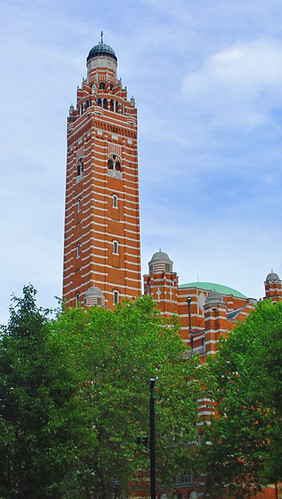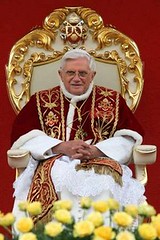The Tintinnabulation that so Musically Wells...
 Every Tuesday evening, the pealing of bells from the tower of the ancient parish church of Holy Trinity resounds across Skipton. It is a most beautiful and uplifting sound, a melodic peal that continues for hours as the bell-ringers, more properly called campanologists, practice their art.
Every Tuesday evening, the pealing of bells from the tower of the ancient parish church of Holy Trinity resounds across Skipton. It is a most beautiful and uplifting sound, a melodic peal that continues for hours as the bell-ringers, more properly called campanologists, practice their art.I have long been fascinated by the sound of church bells; they evoke so much. From the sombre toll of a lone bell at the funeral procession of Diana, Princess of Wales to the joyful cacophony of at the election of Pope Benedict XVI they express our deep sorrow or our raucous jubilation. Bells have an ancient history. The oldest surviving bells, made from cast bronze, survive from around 433 BC and were discovered in China; I have a wonderful recording of courtly music played on these bells. Very soon though, they were used for other purposes than music, as warning devices and time-keeping aids. The most famous bell of all, Big Ben, cast in 1858/9 and which hangs above the Palace of Westminster still sounds the hours daily and is broadcast throughout the world by the BBC.
In 1849 Edgar Allan Poe wrote a poem celebrating the sounds and multi-faceted uses of bells. This was subsequently set to music (albeit in Russian) by Rachmaninov in 1913. Writing from Rome, he said: "The sound of church bells... accompanied every Russian from childhood to grave... All my life I have taken pleasure in the differing moods and music of gladly chiming and mournfully tolling bells." As such, he set 'The Bells' to music to display the spectrum of human emotions and events reflected in the "tintinnabulation that so musically well from the bells..."
The sound of bells is gradually being lost in European cities and I suspect in other Western-influenced countries as well. Once the soundscape of Europe was dominated by bells - from churches, monasteries and civic clock towers. The skyscape of ancient cities was dominated by bell towers, campaniles and one thinks immediately of the most famous of them all which leans in Pisa on the Field of Miracles. As the buildings in cities became taller and the roar of engines grew louder, the bells and their towers faded in importance. The advent of the wrist watch sadly also ended the last real need for them.
I recall being on retreat at Quarr Abbey and the bells dominated the hours of the day and we used it to actually tell the time. It rang to wake us up and call us to church for the early Offices, it sent us into the fields to work, gave cause for pause at the 'Angelus' and then called us in for lunch. It rejoiced after Mass and sent us to bed after Compline. In the early hours of the morning I would lie in bed and count the chimes rather than look at the clock to tell the time. It was a most wondrous sound and feeling. Or the times I used to wake in Germany on a Sunday and hear the church bells ringing across the fields from various churches calling the faithful to Mass; a beautiful sound with which to arise and know I had to rush to church. When I am in Singapore, I truly miss the sound of a church bell, for here the soundscape is punctuated by none such harmonious a chime. Even the building called 'Chijmes' (currently used by the IOC debating the 2012 Olympic City) has none!

But of all the bells that are heard, none can compare with the English church ringing tradition; it is truly unique. Unlike continental church bells, and indeed most bells which are struck by a hammer or swung on ropes, causing the clapper to strike the bell (this method being called 'chiming'), English church bells are 'rung', which means they swing 360 degrees, full-circle. Some of us may remember seeing the bells of St Peter's ringing in April - they merely swing and they do so irregularly, creating a pleasant enough jumble of sounds. English bells don't do this. A trained campanologist pulls on the bell-rope to swing the bell 360 degrees in one direction and then again in the other direction, but never more than 360 degrees. This is called a 'stroke'. In any church tower there are several bells (a set being called a 'ring of bells'). The ring of bells is then interchanged in such a way to give different orders of musical notes. These orders are called 'changes'. The maximum number of changes possible on a given number of bells varies from 120 on 5 interchanging bells to many millions on 12 bells, as at St Paul's Cathedral in London! A full 'peal' consists of at least 5000 changes and no change in a set of changes can be repeated. Mathematically and musically, this is a highly skilled art form! A set of other rules exist which further extenuate the skill involved for a team of campanologists. In short, it is a complex and beautiful art that creates the characteristic English church bell sound. One may have heard them recently at the wedding of Prince Charles to Camilla Parker-Bowles or indeed at his first wedding in 1981!
The names given to the changes are also interesting based on how the changes are rung and in which order and on how many bells. Names such as 'Little Bob Maximus', 'London Surprise Royal' and 'Kent Treble Bob Major' add to the mystique of the campanologist and the charm of their art. However, yesterday's 'The Guardian' reported that some 40,000 British bell-ringers have experienced anxiety that the bells may fall on their heads or they be strangled by the ropes! Others have experienced claustrophobia in the towers or panicked when the towers sway perceptible during a peal! Nonetheless, there are still tens of thousands of campanologists throughout the country and the famous Ancient Society of College Youths (founded in the 16th century) still rings the bells of London's famous churches. The name of the society is instructive: a German visitor to London in 1602 noted that "the young people [ring bells] for the sake of exercise and amusement". Given the number of yobs and bored youth on England's streets, perhaps it's time to send them up the campaniles again!
Certainly, the English church bell is part of the soundscape and traditions of England. To this day, a vicar still ceremonially rings the church bell at his Induction to signify his duty of calling the faithful to worship. Every Sunday, in the wee hours of the morning the BBC still plays a small segment of a peal of bells. And here in Skipton, every Tuesday and weekend, I hear the bells of Holy Trinity ring out, a joyful sound that reminds me of heaven's glory, for at their consecration the bells are entrusted with the mission of praising God and of pleading for the intercession of the saints... Let the bells ring out!
Recordings of English church bells may be heard at this link. The photos above are of the campanile of Westminster Cathedral and the famous church of St Martin-in-the-Fields, famous for its' bells and ringers, the 'Society of Royal Cumberland Youths'.







0 Comments:
Post a Comment
<< Home